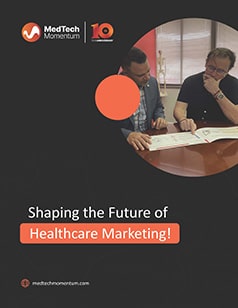
It’s not an easy task, however. Supporting your direct sales efforts – and eventually building online lead generation – takes patience, a test-and-learn mindset, and an understanding of how the levers work within multichannel, and more sophisticated integrated marketing plans.
It doesn’t help that many people (marketers included) are confused about the definition of marketing strategy. I like to use a driving analogy. Your marketing strategy is not unlike a highway. It sets the direction, speed, and tone of your marketing plan. A good strategy has a few key characteristics:
- The strategy doesn’t waver. While you may change up your tactics as you learn more about your audience, your strategies remain the same. This is why integrated marketing plans are often shorter term than more traditional plans, usually 3-4 months.
- The strategy creates familiarity across every channel your buyers and influencers frequent. This is done by creating common assets like videos, photos, testimonials, and others. While they may be translated to suit a specific channel there are common looks, words, CTA’s, colors, and other aspects of the brand that persist.
- The strategy doesn’t always sell. A good marketing strategy provides more opportunities to sell but it doesn’t actually sell. Companies new to digital marketing often try to move their selling online by creating ads that fall flat. Just like any medium, in person or otherwise, a good marketing strategy will warm up an audience online so your sales tactics will have much higher rates of success.
Once your brand is familiar to a specific audience, it becomes much more agreeable. The familiarity principle is a human tendency for preferences to grow in response to repeated exposure to a stimulus. In plain English, we tend to view things more favorably when they’re familiar. It’s one of the basic premises of marketing. As we work across integrated marketing channels, having a consistent strategy that breeds familiarity for your brand is a game-changer. Our clients know the value of the MT7 Framework as the foundation of every marketing strategy we create, which begins with our unique Buyer Persona Workshops. Customizing strategies means taking that framework and incorporating every aspect possible, from your brand position to the statue of the industry.
So let’s talk about 2023 and the marketing strategies that could help you meet your overall goals this year. Of course, your brand’s maturity will determine the nature of the tactics you eventually use. But considering each of these strategies will help you get a good start on your market planning activity.
- There are no leads without lift. Understand how well your potential customers know your brand and work from there. You must continually build brand awareness and knowledge within your buyer and influencer audiences. A strong brand awareness/education strategy is the foundation of your presence in every channel.
- Use multiple channels. To gain familiarity we used to say that a customer needed to see the message seven times. Today, we say that they must see your message seven different ways. You can’t rely on social media or email marketing alone. Your strategy must utilize the right channels, in the right way, and at the right time.
- Invest in inbound marketing. Inbound marketing focuses on attracting potential customers through valuable content and experiences, rather than traditional outbound marketing methods like interruptive advertising. This can include tactics like search engine optimization (SEO), content marketing, and social media marketing. Investing in inbound marketing helps your medtech brand build credibility and establish thought leadership in its industry.
- Go beyond KOLs to true influencer marketing. While we’ll always be after the “big” fish when it comes to key opinion leaders, there are a host of influencers within social media, industry publications, events – and even other companies – who can help spread the message about your brand. Influencer marketing is an entire article all to itself, so I won’t go into it here, but remember that today’s micro-influencers, while they may not have a huge reach, often have deep engagement which is more important.
- Go for engagement not just reach. Initially, you’ll want to cast a wide net if your brand is new to the market, or relatively unknown to a new audience. As you move closer to building a lead generation engine, you want to incorporate tactics that go deep within your audience. Vanity metrics like total followers, sessions, open rates, and others are usually meaningless. Learn how historically buyers have engaged with your brand and track those metrics instead.
- Use paid media (ads) to boost your owned media initiatives. When you find content that works, or you’re trying to gain traction in a new market, use ads to boost your metrics as you learn how buyers engage with you online. You can use ads to sell within specific industry publications, sure. But create a budget that supports your efforts within social media, email marketing, and other broader channel initiatives.
- Don’t forget about earned media (PR). There are still lots of opportunities to gain free publicity if you have a good story to tell. Initially, this may be the story of your company, but those opportunities are limited and will end soon. Find out what your industry publications – and health beat writers – are writing about and find a way to become their favorite subject matter expert. Gain interviews on podcasts, no matter how small the audience. Submit to awards. Write small articles for newsletters, whether they are editorial or partner content. And then use those placements as future fodder for social media, email marketing, blogs, and another other channels your audience may frequent.
- Create feedback loops with your customers and your metrics. Integrating your marketing strategies across channels requires constant feedback as you try new tactics, drop old ones that aren’t working, and tweak others to boost performance. Some digital marketers even watch the numbers daily. While this may not be required, look at them at least once a month and carefully consider each tactic while you keep your strategy the same.
- Tell stories that resonate with your buyers and influencers from an emotional standpoint. The healthcare and medical device industries have traditionally tried to market through education, and by describing features and benefits. If you take away nothing else from this article, it should be that your buyers want to know how you are going to solve their problem. Shifting your selling online is not the answer. Your marketing strategies and content must trigger emotional responses to be effective, so focus on the WHY. (Click here to learn more about the power of “emotionalizing” your brand.
This may seem like a lot of work, but you don’t need to incorporate every one of these strategies right away. As I’ve mentioned before, your brand maturity, and the maturity of the relationships you have with your buyers and influencers online, will drive the specific marketing strategies you deploy.
Just remember, you can’t sell anything to someone who doesn’t know you. Become familiar first, and then move on to build engagement, and more valuable leads.



